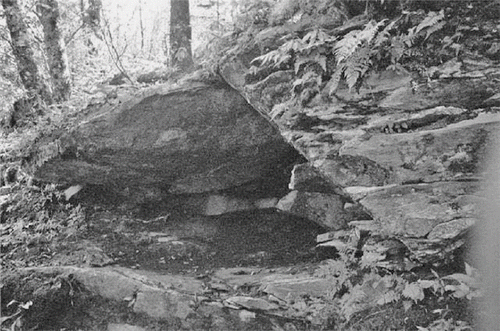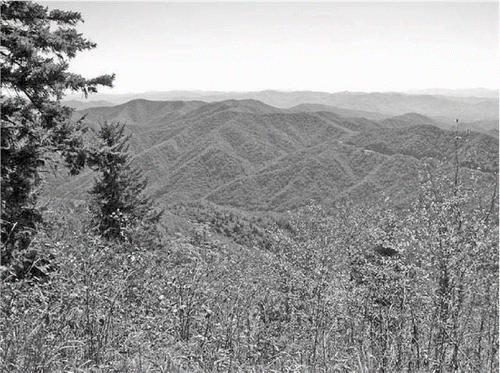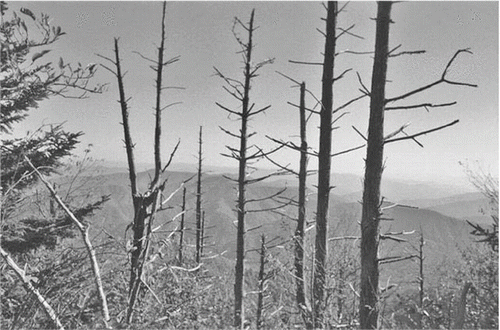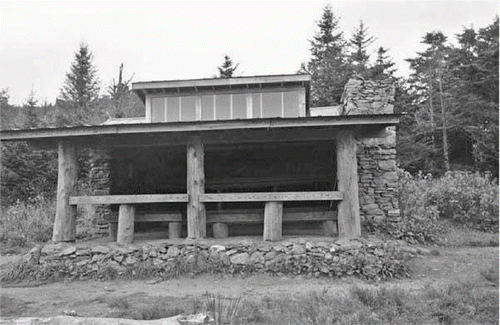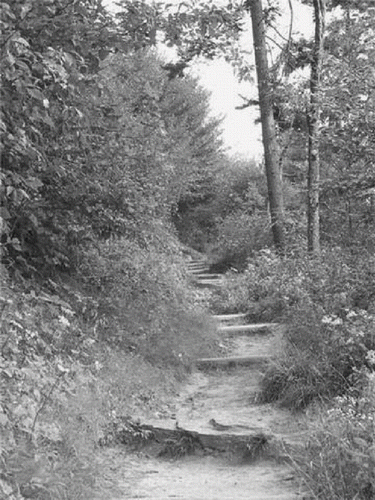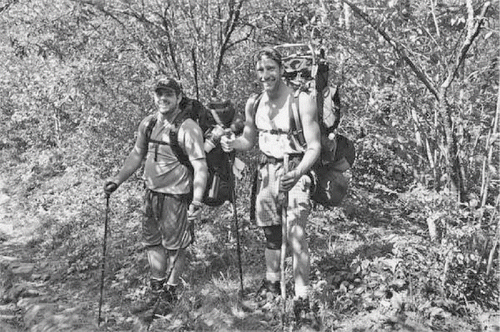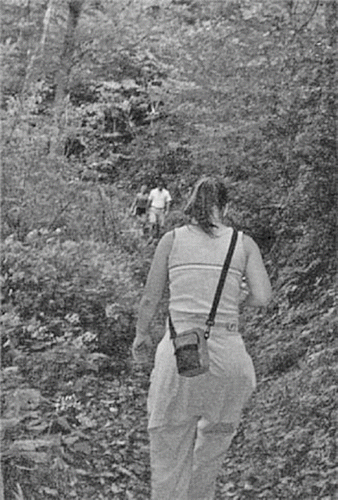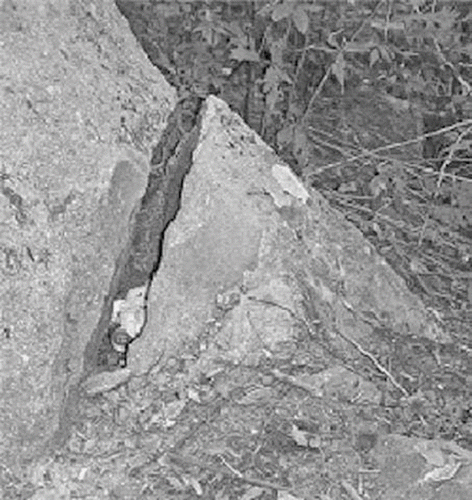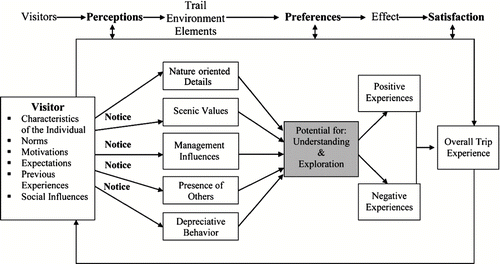Abstract
The purpose of this study is to examine visitors' perceptions and to determine how these perceptions affect their recreation experiences along a segment of the Appalachian Trail in Great Smoky Mountains National Park. The study consisted of two parts—a visitor employed photography exercise and a posttrip interview. Analysis of the photographs and photograph logs show that participants noticed both negative and positive aspects of the trail environment. Five perceptual themes emerged from the interviews: nature-oriented details, scenic values, management influences, presence of other people, and depreciative behavior. Analyses indicate that these elements did not detract from participants' overall outdoor experiences. A model based on the study's findings is proposed to guide future visitor behavior research.
“It reminded me of… well number one it is just beautiful and so it's memorable. But, like the scents, and the sounds, and the sights kind of reminded me of trips we've taken to the northwest… so it's what goes through my mind, it's almost like nostalgia.” (excerpt from Donnie's photo log on the Appalachian Trail, Fall 2005)
Nostalgic memories of trips taken long ago, associated meanings, thoughts, and feelings from a single event can be evoked through the process of experiencing nature. Nature experiences can be deeper than just the act of walking in the woods, fly-fishing, rock-climbing, or camping. These experiences are created and affected by other factors such as family and community (CitationLouv, 1996) and are influenced by visitor attitudes, preferences, and perceptions (CitationNdubisi, 2002). What visitors notice during their visits to managed natural areas can affect their overall experiences. It is the integral link among many facets beyond those strands described by Louv that creates an inclusive web of experience. Understanding the factors that influence visitors' experiences and form and strengthen the interwoven strands of this web is an important prerequisite to fully understanding nature-based recreation and is essential for agencies charged with managing and protecting the natural settings where they occur. Just as a hike on the Appalachian Trail can beckon memories of early childhood trips with one's family, experiences in natural settings can create or strengthen a host of other interwoven strands and have long-term effects on a person's experiences as well as how that individual views and acts toward nature in the future.
The purpose of this grounded theory study was to employ photographs, logs, and interviews to understand park visitors' perceptions of elements of a trail environment and to explore how these perceptions affected visitors' nature-based recreation experiences. Elements of the trail environment explored in this study were identified by users and included sights and sounds on and along the trail, smells, trail surfaces, views, and attributes of the trail that could have negative or positive effects on their experiences. We begin with an overview of related literature, and then describe the research methods used and the results obtained. In conclusion, we present a theoretical model which emerged from the data, and that describes nature-based recreation experiences further.
Related Literature
Preference and perception affect outdoor experiences in many ways. One perspective is that individuals are guided by their evolving preferences and perceptions of the natural world. CitationKaplan and Kaplan (1989), for example, considered preferences to be closely tied to basic concerns and to represent “an expression of underlying human needs” (p. 10), including an ability to thrive and survive. As a result, visitors' preferences for experiences, activities, and management decisions differ greatly.
Perception is closely related to preference. It “is a key element in preference, and the measurement of preference permits an examination of the perceptual process” (CitationKaplan & Kaplan, 1989, p. 11). Perception is “the act of apprehending an object through the senses” (CitationNdubisi, 2002, p. 197). The cultural geographer CitationYi-Fu Tuan (1974) described perception as “both the response of the senses to external stimuli and purposeful activity in which certain phenomena are clearly registered while others recede into the shade or are blocked out” (p. 4). CitationPigram (2003) argued that “perception is basic to an understanding of leisure BEHAVIOUR and recreation decision making, and why people select particular settings and activities” (p. 359). Further, to understand perception, a person needs to take into consideration his/her surroundings because these spaces will provide context for the things he or she sees in the environment (CitationKaplan & Kaplan, 1982). Therefore, whether different elements of the trail environment affect outdoor recreation experiences depends on both the visitor's perceptual and interpretative processes.
CitationNdubisi (2002) suggested that studies of “landscape perception seek to understand human values and aesthetic experiences in order to take them into account in creating and maintaining landscapes that are socially responsible and ecologically sound” (p. 197). Central to this perspective is the belief that visitors interpret their environment in terms of their needs, and prefer settings in which they are likely to function more effectively (CitationKaplan & Kaplan, 1989). A key tenet of environmental perception research is that perception is actually an interaction between humans and an environment that is dynamic, inextricably linked to the whole psychology of the observer, and immersed in the environment that is experienced (CitationTaylor et al., 1995). This belief is also the basis of the landscape perception paradigm (CitationZube, Sell, & Taylor, 1982), which has provided important guidance for studies focused on people's evaluations, conceptualizations, and relationships with the natural environment, particularly those regarding perception and preference in terms of experiences of nature, landscape, and the environment (CitationAlessa, Bennett, & Kliskey, 2003; CitationFarrell, Hall, & White, 2001; CitationFloyd, Jang, & Noe, 1997; CitationHillery et al., 2001; CitationNoe, Hammitt, & Bixler, 1997; CitationPriskin, 2003; CitationWhite, Hall, & Farrell, 2001).
Researchers have evaluated how past experiences, environmental attitudes, and knowledge affect perceptions. For example, CitationAtauri, Bravo, and Riaz's (2000) study of natural areas in Sierra de Guadarrama found that visitors' landscape perception was influenced by the activities in which they participated (e.g., alpine skiing, high mountain use, enjoying nature, or picnicking). They also discovered a relationship between visitors' behaviors, attitudes, and expectations. For instance, the way the “landscape is perceived and the way visitors chose their preferred places is closely related to the activities they carry out, and the degree of alteration they are willing to accept” (p. 59). CitationHillery et al. (2001) established that respondents were more likely to perceive impacts at sites where there had been more tourists and where there was a higher intensity of impacts. CitationPriskin's (2003) study indicated that perceptions are affected by gender, age, and the visitor's level of education. Further, CitationTaylor et al. (1995) showed that those park features most often perceived and listed as having an effect on the visitor's experience were water, vistas, management features, vegetation, wildlife, and human impacts. Finally, CitationLindsey, Wilson, Yang, and Alexa (2008) discovered that trail design is just as important as preference for trail use.
Characteristics of Trails as Natural Settings
Research suggests that visitors tend to prefer settings that are restorative and the opportunities the natural setting affords must be compatible with what the visitor desires. For example, if a person is hiking on a wilderness trail, the “sense of being in a large enough place that its boundaries are not evident” (CitationKaplan, Kaplan, & Ryan, 1998, p. 19) may be vital. Other factors that likely affect a person's experience on the trail are the texture and width of the trail. Therefore, if a trail is badly eroded or widened, then the hiker's experience might not be as satisfactory because people prefer that trails be compatible with the natural surroundings (CitationKaplan et al., 1998). In relation to trail impacts, these environmental disturbances may not be as noticeable if beautiful vistas or scenic waterways are along the trail. Kaplan et al. found that points of interest, views, curves in the path, and waterways attract visitors' attention. These elements may make visitors less perceptive of impacts or the presence of others on the trail, or if they do perceive these elements the effect on their overall experience may be reduced as a result. In CitationLynn and Brown's (2003) study, litter, tree and plant damage, and fire rings were perceived by hikers and had the greatest adverse effects on their hiking experiences. Trail extension, widening, and trail erosion also had moderate negative effects on experiences. Yet, trail erosion-related factors such as roots, gullies, and rocks may actually increase the enjoyment of mountain bikers (CitationSymmonds, Hammitt, & Quisenberry, 2000).
Such factors as the trail's location and situational conditions defining the impact also seem to affect how visitors react to impacts. Studies by CitationNoe et al. (1997) and CitationWhite et al. (2001) found visitors' perceptions of and tolerances for impacts varied widely. White et al. determined that visitors perceived major impacts from a reduction in vegetation cover, compacted soils, and chopped or felled trees. Their results also suggested that visitors were likely to make tradeoffs regarding their evaluations of impacts and the desirability of the site in relation to its functional amenities. For example, some trails may not be as natural but may be desirable to some because they are wide, paved, or provide easy access to desired destinations. Finally, CitationReynolds et al.'s (2007) study found that other variables such as the presence of litter and noise on trails are inversely associated with use, and that the ease and attractiveness of a trail in relation to the presence of mixed views is positively associated with trail use.
Complexity of Visitors' Perceptions
Additional research points to the complexity of visitors' perceptions. CitationLucas (1979) suggested that visitors actually have a “genetic vision,” and that two aspects of perception exist that managers, planners, and researchers need to consider: “(1) the perceived importance of impact conditions relative to all other aspects of the wildland recreation setting (such as scenic appeal, fishing, solitude, freedom) and (2) the evaluation of any given physical-biological condition in desirable/undesirable terms” (p. 24).
To support this view, CitationGobster's (1995) study demonstrated how the design of recreation areas and trails affects user perceptions and preferences. He found that users valued scenic beauty and trail elements such as safety management as well as peace and quiet the most when using a greenway trail. Further, users negatively perceived trails that had poor maintenance, rough surfaces, potholes, and horse manure. Yet he noted that different user groups rated their preferred trails differently depending on whether they were bicyclists, walkers/joggers, or horse riders. In a more recent study, CitationGoossen and Langers (2000) ascertained that the most important quality indicators were access to areas of natural beauty (i.e., for walkers) and tranquility (i.e., for bikers). They also noted that no significant differences existed among different user types regarding the dimension of perception quality, which is “that quality of the environment which people notice or experience (such as the beauty of the landscape or tranquility)” (p. 241).
Taken together, an examination of current literature presents many contradictory results and explanations for visitors' perceptions, preferences, and recreation experiences. These inconsistencies have led to further exploring visitors' experiences and to attempt to resolve the evident contradictions.
Methods
Site and Sample
This study took place in Great Smoky Mountains National Park (GRSM) located in North Carolina and Tennessee. Nearly all of the park's 800 square miles are proposed as designated wilderness and are managed for “unimpaired” resources and outstanding opportunities for primitive and unconfined recreation. The park's trail system provides visitors with a diversity of recreation opportunities depending on interest, skill-level, and setting preferences. A 2.9-mile segment of the Appalachian Trail (A.T.) headed north out of Newfound Gap was selected for study because it was a single-track natural trail with a variety of resource conditions, well traveled, scenically beautiful, and easily accessible for both users and investigators.
A purposive sample of 33 day hikers were intercepted at the trailhead at Newfound Gap during the months of September and October 2005 and asked to participate in the study. Data collection took place on two weekdays and two weekend days to secure a more diverse sample. Only visitors who planned to hike up and back along the entire 2.9-mile stretch between the Newfound Gap trailhead and the Icewater Spring trail shelter that day were chosen. Of the approximately 47 visitors asked to participate, 14 refused because they were not planning on coming back that day (e.g., they were camping), they did not know if they could make it to the shelter and back, or they just were not interested in participating.
Instruments
Data were gathered using Visitor Employed Photography (VEP), respondent photo logs, and posttrip interviews. VEP was adapted from previous studies (e.g., CitationKim, Lee, & Shelby, 2003; CitationLynn & Brown, 2003; CitationTaylor et al., 1995) and entailed having participants take pictures along the trail, documenting information about their pictures and experiences in a written log, and participating in an interview after their trail hike. Once the park visitors agreed to participate, they were given disposable 24-exposure digital cameras and asked to photograph those elements/features of the trail environment they noticed added or detracted from the quality of their experiences. The goal was to capture images of elements or locations in the trail environment that had the strongest effects on the quality of the participants' trail experiences.
In addition, each participant was given a “Photograph Log Booklet” and asked to record details for each photo that related to each participant's general experience on the trail that day. Specifically, the photograph log asked such questions as: (a) “What element/feature of the trail environment did you photograph?” (b) “Describe why you selected this element/feature of the trail environment to photograph?” and (c) “Describe what type of effect this element/feature of the trail environment had on your overall experience?” This data focused on the photographers' intentions regarding the object or scene photographed.
After participants returned from the hike, they were asked to turn in the cameras and logs, and then to answer several open-ended questions related to their trip such as: (a) What motivates you to use this trail? (b) What types of features along the trail do you find yourself photographing? (c) How did the feature affect your experience? and (d) Overall how satisfied were you with your trail trip? A general interview guide approach was used (CitationPatton, 1987), and the answers to these questions were voice recorded and later transcribed for analysis. The semi-structured interviews supplemented the VEP assessment and led to richer and thicker descriptions of each participant's experience. After visitors completed their photo logs and interviews, they were asked to fill out a brief note card, which documented how many times they visited the park and basic user information.
Data Analyses
Data analyses for this qualitative study involved constant comparison with both the journals and interview transcriptions and content analysis of the photos based on recommendations by CitationStrauss and Corbin (1998) and CitationHenderson (2006). Once the data sets were compiled, we began a process of constant comparative analysis that involved open and axial coding. In open coding, initial categories of information about the visitors' perceptions and their outdoor recreation experiences were formed. In each category, properties or subcategories were identified. Next, the data were coded using axial coding to develop central themes. Finally, enumerative strategies were used to supplement descriptive data resulting from analysis of the journals and the interviews (CitationHenderson, 2006).
Photos were divided into two groups based on whether the participant had indicated in their photo log that the elements photographed were positive or negative. Each group was then organized based on themes. Photos were also coded and numbered to determine how many times each theme was photographed. Data within each photograph were then coded and counted to see which particular attributes of the trail (e.g., scenic vistas, fallen trees, exposed tree roots, people) were photographed most often. Only the main attribute was identified per photo. These attributes were then categorized.
To minimize bias and to ensure accurate interpretation of the photo data, several additional strategies were employed to check the accuracy of findings. These included (a) data triangulation; (b) using rich, thick descriptions to convey the findings; (c) clarifying my (i.e., the first author) potential bias in a written self-reflection that explained my viewpoints and perspectives; and (d) taking advantage of peer debriefing to increase the accuracy of written accounts (CitationCresswell, 2003).
Findings
Study participants were well educated, came from households with a high-income level, and were first time users of this part of the A.T. Forty-two percent of the participants were male, and 58% were female (see ). Some individuals were avid backcountry hikers (i.e., their goal was to hike farther than 2.9 miles that day). Other participants were there primarily to enjoy nature. Some participants reported using the trail because they wanted to take a leisurely hike with their families or partner, while others were there to get away from stressful lives. Analysis of the photographs (n = 274) and photo logs (n = 33) revealed that participants noticed both negative and positive aspects of the trail environment. Overall, 83% of the pictures contained attributes that visitors liked, and 17% of the pictures contained attributes that were disliked. In both sets of photographs (i.e., those reflecting attributes that visitors liked and disliked) the same five perceptual themes emerged: nature-oriented details, scenic values, management influences, presence of other people, and depreciative behavior. The order reflects each theme's relative frequency, from the element that was captured most often in the photos to the elements least photographed.
TABLE 1 Summary Description of Study Participants.
Nature-oriented Details
Positive attributes Whether hiking alone or with a group, each of the 33 participants noticed and photographed more nature-oriented details such as plants and wildlife than any other type of feature (see ). When asked what they were photographing and the type of effect seeing these elements had on the recreation experience, Angel and Buffy noted their appreciation of the “flowers and bees… nature working its lifecycle” and the “calming” effect that perceiving these elements had on their visit. Faith and Julie noted the positive effect the plants had on their experience. “Dead tree with mushroom [and] moss… [which was] allowing dead growth to support existing growth—ecosystems” was reminiscent to them of “how nature wanted it to be.” Caitlin and Cordelia found solace in the “green ground cover [and] moss in roots of the tree” because it was “so delicate in texture… brilliant green [and] soft.” They noted, “It is the simple small parts of nature that we are amazed by even in a large massive forest.” You know it's just appreciation of the small details… and if you are not paying attention, you miss them.”
FIGURE 1 Photograph taken by Faith and Julie reflecting nature-oriented detail (mushrooms) that was liked.
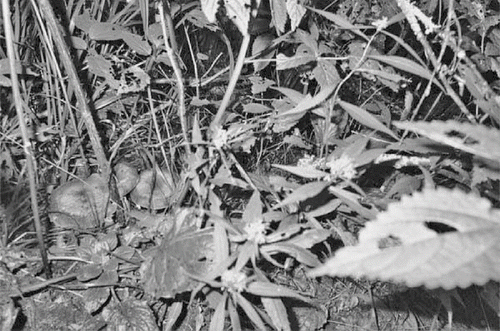
Negative attributes The same types of nature-oriented details that so many visitors considered as positive parts of their experience also had a negative effect on a few users' experiences (see ). For instance, one hiker claimed that she took a picture of “moss covering tree roots” because it “detract[ed] from [the] overall natural beauty” of the area (Buffy). Similarly, a young mother visiting with her family wrote that seeing a natural “cave” had a negative effect on her experience, because it made her a “little scared because [she] wasn't sure what was living in it” and seeing a “snake hole” later down the trail made her “walk a little faster” (Joyce).
The data related to this theme showed that many visitors perceived the “small details” of nature that surrounded them on this trail and found pleasure in them. However, some found uncertainty, fear, and anxiety from those natural elements that they felt were unattractive or unfamiliar. Overall, small plant life, wildlife, interesting rock formations, and the organisms that fed and thrived in this ecosystem were noticed and had an effect on respondents' experiences.
Scenic Values
Positive attributes Scenic views were the second most photographed category of elements (see ). One male hiker, who had also visited this trail section many years ago, found joy in the “high altitude vistas.” He (Giles) wrote in his log that “it's one of the reasons I chose this hike [for the] inspiration (hey I'm a pastor—inspiration is my business).” Lila and Donnie agreed saying it is the “trees, scenery, beautiful view” and we “appreciate the purity of nature” because it is “calming.” A sense of appreciation was conveyed by some of the respondents for the beauty provided by this part of the Appalachian Trail and the surrounding national park. When asked in the posttrip interview what types of features they photographed, Lindsey claimed it was the “fantastic, beautiful views.” A young couple, Donnie and Elizabeth, agreed, adding, “You know it was the entire package. I mean the views and the smells, and the shade. The breeze.” Xander, who had traveled this part of the A.T. previously and kept coming back, noted that “from my experience this has more scenic overviews or scenic lookouts you know then any other trail in the mountains or any part of the A.T. that I've been on.”
Negative attributes Though each participant appeared to love the views, such negative aspects as perceiving invasive species, tree damage, vehicle noise, pollution or smog, and acid rain came up often in respondents' logs as negative aspects of some of the views photographed (see ). For instance, Bob wrote that seeing both the “view and haze” had a negative effect on his experience. “Hiking for views is an important part of [the] Smokies experience. [I] love the views but [am] concerned about the air quality.” Similarly, Caitlin and Cordelia, two female science teachers, were deeply disturbed by the “dead trees… I hate to see the dead trees because they are dying from disease…. “[We] are sad and concerned for the future use of the forest.” Likewise, Tina noted, “It is sad to see diseased trees… dead trees, natural and destructive. [It is] negative, but reality.” Scenic is often used to describe something related to natural scenery. Many of the visitors indicated that they had chosen this trail due to its scenic potential and in their interviews expressed joy in the beautiful vistas and scenes afforded from various lookouts. However, when attractive views and vistas were marred by smoggy conditions or trees dying, respondents indicated that the scenic values of this trail were compromised. Therefore, the same elements that afforded positive experiences, also led some to feel sad and concerned for the future of the park.
Management Influences
Positive attributes The third theme to emerge was a frequent perception, and often an appreciation, of trail and park management practices along this trail segment (see ). Bob wrote next to his picture, “Shelter at Icewater Spring… very nice… I'll be back to camp!” Glory concurred expressing that the shelter was “neat and well kept… [and provided] a nice rest.” Giles recorded, “Stairs on a long uphill stretch… somebody went to the trouble and expense of trail maintenance.” He appreciated the “ease of use and safety” and that it “controls erosion.” Similarly Angel and Buffy photographed “natural steps” because they “liked the natural rock formation incorporated into [the] trail.” It left them “pleased” with the experience. Bob felt that the “trail signs [were] an excellent feature” because it was a good way “to keep track of progress.” Finally, Giles noted that the “white blaze markers” were helpful because he “found [him] self looking for them when unsure of trail direction.”
Negative attributes As with other themes, the same elements that some hikers found positive left others with unpleasant reactions (see ). Gigi noted, “signs… lack of info… we went the wrong way.” She recommended that better marked trails would increase “ease of use and [lead to] less frustration.” Buffy and Angel's experiences were also affected by the “log stairs [which]… detracts from [the] natural trail.” Similarly, two young males (Jonathon and Lorne) found that the stairs were “too many… too close together.” All the participants perceived efforts by management to “improve” the quality of the trail and trail environment, although some participants disliked the improvements but still noticed them. Whether through directional signs, blazes, waterbars, shelters, erosion control, or the clearing of trees fallen across the trail, managers' actions affected visitors' experiences.
Presence of Others
Positive attributes The exploration of this theme indicated that most participants perceived the presence of other people along the trail. However, analysis of the pictures and log entries indicated that people were almost equally split between instances when seeing others had a positive or negative effect on their experience (see ). Anya noted the positive effect her group experienced from seeing others, “Friendly hikers, people you meet… what's not to like about the A.T.” Cordelia and Caitlin appreciatively noted “backpackers… hot hikers… people getting away from crowds and taking advantage of the park… wow, I'm always impressed with backpackers!” Sometimes, it also seemed that the type of person or people met and what they were doing influenced whether or not the experience was positive.
Negative attributes Bob claimed that “people [had a] substantial effect on the wilderness experience” and that he “would prefer to encounter fewer people” during a hike on the A.T. Donnie and Elizabeth had a similar perception of possible crowding problems and wrote, “people … every other minute you run into other people [there is] no seclusion or privacy.” Faith also did not like all the people stating, “People ‘hiking’ on [the] trail aggravated the experience.” This perception included a negative experience with “impatient hikers ‘pushing’ [her] along the hike” (see ). When asked how her trip was, Tara said that she and her husband would have liked to have seen “a few less people (laughter) – it IS a well used trail!” Faith and Julie even referred to the number of other people on the trail as “like cattle,” which negatively affected their experience until they “got further up… away from the groups of people.”
Depreciative Behavior
Negative attributes Unlike the other four themes, this theme was the only one that included pictures, comments, and attributes that were all negative and universally disliked (see ). Giles related his disgust of some people's actions by including a photograph of a “tree used as a bathroom… [noting] it definitely affected my experience today… Some guy had just stopped to crap about six feet from the trail and it reeked!” Spike and Tina wrote that seeing a “water bottle in the brush… it shouldn't be there…it's discouraging to see people can't carry their trash out with them” negatively affected her experience. Julie photographed a “cigarette butt on [the] trail” and explained, “People should leave no trace behind—it is a nuisance when people are smoking on the trail.” Finally, Anya found that seeing “Trash” left her and her friends with a bad experience by exclaiming, “Pitiful! Smoking on the A.T.? Leaving Butts? This is what not to like about the A.T.” An exploration of the interviews revealed that some depreciative behavior was noticed by many of the participants, but the overall trip experience was not overly impacted. In fact, those interviewed seemed to have had an expectation that there would be even more depreciative behavior (i.e., litter) than they saw.
Effect on Experience
Taken together, the various elements of the trail and trail environment had an effect on participants' experiences. Results from posthike interviews showed that although participants perceived both negative and positive aspects of the trail environment and noted that seeing some things had negative effects on their experiences, all participants indicated having an overall positive experience. The following excerpts from Wesley and Sarah's interview illustrates this view:
Wesley: Yes, when we started out there were some dead trees that in the wind seem that someday will come down… and ahh I don't know – if you know they used to call those “widow makers”? (nervous laughter)
Interviewer: Oh they still do.
Wesley: Ummm, I don't know if they do that sort of maintenance on the trail?
Interviewer: So it was more of a negative experience than a… ?
Wesley: Oh, it was a little negative but going out—coming back with the blue skies… it's very beautiful!
Sarah: It's pretty.
Yeah we took some pictures of Joe and me and a lot of hikers and we just took pictures of things that we thought were beautiful, but then we took a picture of a… we saw a cigarette butt and so we said ohh! We have to take a picture of this horrible cigarette butt. You know, it was great. We had a wonderful time!
Discussion
Possible explanations for visitors' perceptions of elements along the trail along with several formal theories to further substantiate the findings are important to consider. Taken together, the literature and the findings enabled us to construct a model to assist in further understanding visitor perceptions.
We concluded from this study that noticing elements along the trail did not detract significantly from the nature of the outdoor experiences. However, noticing positive elements of the trail environment may have increased the quality of these experiences. Though the participants perceived both negative and positive aspects of the trail environment, they had an overall positive experience. Another indication of how study participants felt about their overall trip experience was their satisfaction with the hike in spite of the fact that most of them also related observations and feelings about negative elements of the trail either in their journals or interviews.
Whether hiking alone or with a group, participants' perceptions were dominated by nature-oriented details such as plants, wildlife, rock formations, and other elements of the natural environment. These findings were consistent with past trail perception and preference research, which indicated that people prefer trails that are compatible with the natural surroundings and that perceptions of only certain aspects of the trail environment affect experiences. This idea also supports the contention that nature content is an important characteristic of preferred scenes (CitationKaplan & Kaplan, 1978). Results were also consistent with previous studies indicating that users have a general affinity toward scenes with a combination of natural elements (CitationGobster, 1995; CitationGoossen & Langers, 2000; CitationKaplan & Kaplan, 1989; CitationKaplan et al., 1998; CitationShafer, Lee, & Turner, 2000).
Nature-oriented details also appeared to have mostly a positive effect on visitors' experiences. This outcome could indicate that people's responses to nature are not predicated by cultures or differences. Rather, similarities in responses to natural scenes may outweigh the differences among various individuals, groups, and cultures (CitationVan den Berg, Vlek, & Coeterier, 1998), leading to more similar than dissimilar perceptions and experiences.
The data revealed that participants also preferred such scenes as picturesque overlooks, mountain ranges, and valleys. Because these scenic values were important elements of trail experiences, this lent support to research that points to “human preferences for natural looking landscapes that include canopy trees or water features, and that allow views out across the landscape” (CitationNassauer, 1995, p. 231). The fact that views were important could help explain why many participants were perceptive of and negatively affected by noticing tree disease and damage as well as poor visibility/air quality. However, not all participants noted both positive and negative aspects of scenery. One explanation may relate to visitors' previous knowledge of negative resource impacts. Buyoff et al.'s (cited in CitationUlrich, 1983) research suggested that preferences for certain landscapes are based on knowledge of the natural settings. They found that seeing tree damage from insects (i.e., southern pine beetles) diminished preference among observers who were informed about the damage or who were knowledgeable about forestry.
Participants were also perceptive of management influences to maintain and improve the trail itself. The majority of the pictures in this theme were positive, perhaps because “nearly all landscapes are judged and enjoyed according to the degree that they clearly exhibit care” (CitationNassauer, 1997, p. 68). This viewpoint was evident in positive perceptions of erosion control efforts (e.g., waterbars), trail signs and blazes, and the trail shelter.
Yet some visitors had negative remarks about trail maintenance efforts. Many felt the trail should be left as natural as possible. Perhaps the unnatural appearance of the waterbars (i.e., human impact on the trail) and the inconvenience of having to step over the numerous waterbars may have led visitors to have negative experiences related to these elements. In addition, there may have also been a safety issue since visitors had to look down frequently to see where they were walking to avoid tripping over a raised water bar, instead of enjoying the views surrounding them. Therefore, perceptions in this theme were often conflicting.
As with scenic values, differences in perceptions to management influences may have been related to diversity in respondents' backgrounds. Several of the participants were active in conservation efforts and pointed out various resource impacts, trail maintenance objectives, and management practices. Others were less familiar with the backcountry. Some research suggests that those landscapes that have rough ground textures and unstructured high complexity will elicit low preference or dislike (CitationKaplan & Kaplan, 1989; CitationUlrich, 1983). Hence, the rockiness and number of waterbars may have negatively affected some visitors' experience. CitationCole (1996), however, found increasing preferences for higher standard trails. The frequency of pictures of trail signs and blazes was consistent with past research suggesting that visitors were most comfortable and satisfied when there was understandable information such as signs and landmarks that ease a person's ability to way find, understand the trail environment, and provide orientation (CitationKaplan et al., 1998).
A mixed set of positive and negative effects resulted from noticing and encountering the presence of other people on the trail. This fact may be because visitor conflict is often asymmetrical (i.e., one group consistently reports that it has a conflict with another group all or most of the time, but the other group reports little or no conflict; CitationHoger & Chavez, 1998). When desired experiences were in conflict, participants reported negative effects.
Another reason why visitors may have been affected differently by their encounters with others could be due to their varying attitudes and norms. Each person's norms may have influenced how they perceived others on the trail and how they responded during their encounters due to differing cognitive and emotional components (CitationHeywood & Murdock, 2002). Participants' different norms (i.e., standards of evaluation or preferences) likely influenced their motivations, attitudes, perceptions, and eventually their satisfaction with their trail trip.
Unlike the other four themes, the depreciative behavior theme was the only one that included pictures, comments, and attributes that were exclusively negative and detracted from the quality of visitors' experiences. These results were consistent with previous research finding that depreciative behavior such as litter in natural areas is often distasteful (CitationFloyd et al., 1997; CitationShafer & Hammit, 1995; CitationRoggenbuck, Williams, & Watson, 1993). Roggenbuck et al. also found that noise, litter, and tree damage detracted from wilderness experiences. Visitors in their study rated site impacts as having greater influence on their wilderness experiences than encounters with others on the trails.
Theoretical Foundations
Several theories can be used to explain contradictions between perceptions and the feeling of an overall positive experience. Cognitive Dissonance Theory (CitationFestinger, 1957) and the Theory of Affective Response (CitationUlrich, 1983) stand out to help explain the process of negotiation and rationalization that emerged from the data. Further, biological theories such as prospect-refuge theory (CitationAppleton, 1975) and information processing theory (CitationKaplan & Kaplan, 1989) are also useful in accounting for the visitors' perceptions and preferences on this part of the A.T. Other research (e.g., CitationGibson, 1987, Citation1994) suggested that people perceive the world around them in terms of how successfully they might negotiate the environment. These perceivable possibilities for action have been called affordances. Therefore, what the trail affords can and in some cases probably did enhance participants' overall experiences. The above theories all focus on the complexity of attempting to explore visitors' perceptions of the natural environment and provide insight into the trail elements participants preferred in this study.
Emerging Theory: A Model for Nature-Based Recreation Experiences
Each of the theories discussed could be helpful in explaining aspects of the interactive processes between people and the natural environment that emerged from our study. CitationKaplan et al.'s (1998) information processing theory is particularly applicable because it helps clarify why people might have responded to the trail environment based on the elements they perceived along the trail and how these different elements were organized. However, this theory still seems insufficient in explaining the dynamic process that takes place when people visit trails, parks, or other natural areas. Results from our study indicated that visitors' perceptions, preferences, and experiences were complex and that noticing positive elements on and along the trail environment may contribute to an increased overall positive experience, but that noticing negative elements might not negatively affect visitors' overall experiences.
Results suggested that no single aspect of what people notice dominated their overall experiences and that the whole person needs to be considered to understand what it is about a landscape that contributes to overall satisfaction. The configuration of the landscape; motivations influencing outdoor recreation behavior, norms, social aspects, or group influences; aspects such as an individual's attitudes, preferences, and perceptions; or their sense of comfort, previous knowledge, and past experiences all seem to play a role in affecting what a visitor notices, which in turn affects their overall experience. Only by exploring the intricate interrelationship of the whole person to the environment will researchers and managers understand the outcomes resulting from visitors' interactions with the natural world.
We propose a model explaining how the trail environment may have been perceived and how it affected the overall trip experience (see ). Its foundation is CitationKaplan and Kaplan's Preference Matrix (1989), which is a three-dimensional matrix explaining how visitors understand (i.e., coherence and legibility) information from the setting and how they view the environment regarding its potential for exploration (i.e., complexity and mystery). Our model also draws on other aspects of outdoor recreation behavior to propose a parsimonious explanation for this study's main discoveries.
The model begins with the main focus of this study, the trail visitor. The model illustrates that visitors have differences in terms of characteristics, motivations, expectations, previous experiences, and social and cultural influences. Social scientists have examined social and individual characteristics of outdoor recreation participants to explain what activities and experiences people seek. Emphasis has been placed on such aspects as culture, which often “filters landscape perception” (CitationNassauer, 1995, p. 234), ethnicity, income level, age, occupation, and demographics. Considering these characteristics is imperative because they influence the type of outdoor recreation activities that a person engages in, what is perceived during a trip, and could be the most influential factor in guiding the outdoor recreation experiences that each person seeks.
Related to characteristics of the individual visitor are norms. Norms are the standards that individuals use for evaluating behavior, activities, environments, and management proposals as good or bad, better or worse. Because social influences are ever-changing, norms will be dynamic throughout life as well. One person's norms, standards of evaluation, or preferences are no better or worse than another's. They may be different and will therefore influence the type of motivation, dictate the attitudes and perceptions, and eventually affect the satisfaction with an experience and the activities.
Key to understanding these elements is being able to follow the evolution of research in outdoor recreation interpretation. As CitationManning (1999) explained, studies by researchers over the last 20 years have led to a shift from an activity approach to a behavioral approach and focus on why people participate in recreation activities and the benefits gained from such participation. We argue that the “why” of outdoor recreation behavior will be strongly affected by the social influences and norms that a person brings to the outdoor recreation table. In the same light, social influences will affect whether a person has a positive or negative attitude, what their perception of the activity or experience is, and what outdoor recreation experiences they prefer.
Perceptions are another key element of our model. CitationKaplan (1985) proposed that visitors respond not only to the elements they see but also to their arrangement and what that arrangement makes possible. Accordingly, some types of information can attract more attention than others (CitationCherem & Driver, 1983). Visitors' surroundings also provide context for what is seen in the environment and can affect how each individual interprets what they see. Therefore, visitors may perceive certain impacts such as litter, scenic vistas, trail erosion, or nature-oriented details, but their surroundings will affect how these perceptions are interpreted.
Preferences are also important in the model. Categorization takes place when visitors combine elements in the outdoor setting that they previously may not have associated with each other. Such categorizations become part of the reality of people who have similar sets of categories. “Categories appear to be reasonable, widely accepted bases for describing the reactive environment” (CitationKaplan & Kaplan, 1989, p. 19). These categories then provide a means to examine environmental preferences, or the type of outdoor recreation setting that a visitor will prefer. Researchers (e.g., CitationPetrick et al., 2001) have found that motivations for recreation are often related to a user's attitudes, preferences, and perceptions and can, therefore, greatly influence the other elements of the model.
The concluding element in the proposed model is satisfaction. The basis for making satisfaction the final element of the model is grounded in expectancy theory—the notion that participants engage in recreation activities with the expectation that this activity will fulfill needs or lead to other desired states (CitationBichis-Lupas & Moisey, 2001; CitationMoore & Driver, 2005). This fulfillment (i.e., the desired state attained) is considered to be satisfaction. Therefore, to understand why a person is satisfied with her or his experience, one must examine all aspects of the person in an integrated way. Social aspects influence the group undertaking the activity and the individual visitors that comprise the group. They may affect the norms, attitudes, or perceptions of the activity or experience. Preconceived notions also play particular roles. In addition, the researcher needs to consider what motivations the person has and how these motivations influence how satisfied s/he is with the experience.
Finally, CitationHull, Stewart, and Young (1992) found that recreation benefits and the experiences attained are not always static but rather dynamic in nature. Therefore, the proposed model includes a feedback loop, since after each trip individuals will have a whole new set of experiences, which will later influence the other steps in the model.
Model in Relation to Emerging Themes
Participants in our study perceived various elements along the trail environment that were grouped into the following five themes: nature-oriented details, scenic values, management influences, presence of others, and depreciative behavior. When visitors noticed these elements, they assessed them based on the trail environment's potential for understanding and exploration. This mental assessment led each visitor to have high or low preferences for the elements and, hence, the setting. These preferences led to both positive and negative experiences. However, due to the visitors' social characteristics, social influences, and motivations for visiting this part of the Appalachian Trail, all participants reported having an overall positive experience. Therefore, a visitor's perceptions and preferences for certain settings should not be viewed in isolation from other aspects of the visitor experience. The interaction of human perspectives combined with various elements found in the landscape, or in this case the trail setting, can create various outcomes (CitationZube, Pitt, & Anderson, 1974; CitationZube et al., 1982). Since factors such as information, satisfaction, behavior, and values all have implications for how outdoor recreation engagements are experienced, participants' perceptions might not be the most important contributors to overall trip experiences.
In sum, articulating a model that fits visitors' perceptions and explains how their perceptions affect experiences is challenging. A review of current literature indicates that a consensus does not exist on which elements are most important in molding the experience, nor does a concise model link all elements. However, the elements that are included in the model proposed in this article are all important in dictating how a natural setting is perceived and are interlinked in the process of attaining a satisfactory experience. Finally, it is important to recognize the dynamic nature of the proposed model. Its elements are always changing and shifting as a person matures and situations change. Like life, it has to accommodate the unexpected events that make life interesting and complete.
Conclusion
The purpose of this grounded theory study was to better understand park visitors' perceptions of a specific hiking trail environment and to explore how their perceptions affected their overall recreation experiences. The study revealed that these particular participants were noticing elements along the trail and noticing these elements affected different aspects of visitors' experiences. However, significant gaps remain in an understanding of the process and dynamics of visitors' experiences. Although this study adds to an increasing body of knowledge focused on visitor perceptions and gathered data using an approach not common in the recreation and leisure literature (i.e., visitor employed photography), the findings provoked many questions for future research and practice.
Results from this study could be valuable in developing future research tools and instruments for measuring visitor perceptions, and the proposed model could serve as a guide for future recreation behavior research. Future research using VEP in trail settings should be undertaken in various settings, in different seasons, and with larger and more varied samples. In addition, researchers may want to compare perceptions of impacts/conditions along the trail to actual impacts and apply the findings to different types of trails (e.g., quality levels, urban greenways). Additional research also needs to be undertaken that examines the effects among participants. Exploring the interaction that takes place among participants in the same party (e.g., while taking pictures, recording thoughts in the journals, during post-hike interviews) merits further examination. Another potential area for future research lies in applying this technique with different age groups (e.g., children and adolescents), in varying natural environments, and with participants from different cultural back-grounds.
Results also suggest the potential value of park staff making time to talk with visitors regularly to better understand their perceptions of recreation environments. However, managers need to keep in mind that these responses/results may not be applicable to all recreation settings. For instance, differences inherent in the type of trail (paved, natural), location (backcountry, frontcountry), type of user and desired activity, and region of the country should be taken into account. Being able to identify elements that are applicable to each manager's trail environment is essential to effectively assess new management actions. Another application of this study's results is in the methodology used. Site managers may want to consider implementing VEP as a tool to explore visitors' perceptions and preferences. Finally, researchers and managers may want to focus on the thematic categories of trail elements identified in this research as a foundation when deciding where to allocate scarce funds and resources. These categories could serve as baselines when creating larger surveys geared toward exploring visitors' experiences.
Our study explored an innovative method of inquiry and allowed an introspective look at the trail environment through visitors' eyes. Researchers and managers should both strive to better understand how trail design and management affect trail visitors' perceptions and experiences, so that settings can be created that more effectively facilitate targeted experiential opportunities. Regardless of which activity group or level of difficulty a trail is intended to serve, understanding how the trail environment is perceived and how those perceptions are affecting users and their experiences is important.
Notes
1 All study participants were given the pseudonyms appearing here by the principal investigator.
References
- Alessa , L. , Bennett , S. and Kliskey , A. 2003 . Effects of knowledge, personal attribution and perception of ecosystem health on depreciative behaviors in the intertidal zone of Pacific Rim National Park and Reserve . Journal of Environmental Management , 68 : 207 – 218 .
- Appleton , J. 1975 . The experience of landscape , London : John Wiley & Sons .
- Atauri , J. , Bravo , M. and Ruiz , A. 2000 . Visitors' landscape preferences as a tool for management of recreational use in natural areas: A case study in Sierra de Guadarrama (Madrid, Spain) . Landscape Research , 25 ( 1 ) : 49 – 62 .
- Bichis-Lupas , M. and Moisey , R. 2001 . A benefit segmentation of rail-trail users: Implications for marketing by local communities . Journal of Park and Recreation Administration , 19 ( 3 ) : 78 – 92 .
- Cherem , G. and Driver , B. 1983 . Visitor employed photography: A technique to measure common perceptions of natural environments . Journal of Leisure Research , 1 : 64 – 83 .
- Cole , D. 1996 . Wilderness recreation: Trends in use, users and impacts . International Journal of Wilderness , 2 ( 3 ) : 14 – 18 .
- Cresswell , J. 2003 . Research design: Qualitative, quantitative, and mixed methods approaches, , 2nd ed. , Thousand Oaks, CA : Sage Publications .
- Farrell , T. , Hall , T. and White , D. 2001 . Wilderness campers' perception and evaluation of campsite impacts . Journal of Leisure Research , 33 ( 3 ) : 229 – 250 .
- Festinger , L. 1957 . A theory of cognitive dissonance , Stanford, CA : Stanford University Press .
- Floyd , M. , Jang , H. and Noe , F. 1997 . The relationship between environmental concern and acceptability of environmental impacts among visitors to two U.S. national park settings . Journal of Environmental Management , 51 : 391 – 412 .
- Gibson , J. 1987 . The perception of visual surfaces (originally published in 1950) . American Journal of Psychology , 100 ( 3/4 ) : 646 – 664 .
- Gibson , J. 1994 . The visual perception of objective motion and subjective movement . Psychological Review (Special Issue) , 101 ( 2 ) : 319 – 323 .
- Gobster , P. 1995 . Perception and use of a metropolitan greenway system for recreation . Landscape and Urban Planning , 33 : 401 – 413 .
- Goossen , M. and Langers , F. 2000 . Assessing quality of rural areas in the Netherlands: Finding the most important indicators for recreation . Landscape and Urban Planning. , 46 : 241 – 251 .
- Henderson , K. 2006 . Dimensions of choice: A qualitative approach to recreation, parks, and leisure research , State College, PA : Venture Publishing, Inc .
- Heywood , J. and Murdock , W. 2002 . Social norms in outdoor recreation: Searching for the behavior-condition link . Leisure Sciences. , 24 : 283 – 295 .
- Hillery , M. , Nancarrow , B. , Griffin , G. and Syme , G. 2001 . Tourist perception of environmental impact . Annals of Tourism Research , 28 ( 4 ) : 853 – 867 .
- Hoger , J. and Chavez , D. 1998 . Conflict and management tactics on the trail . Parks & Recreation , 33 ( 9 ) : 41 – 51 .
- Hull , R. , Stewart , W. and Young , K. 1992 . Experience patterns: Capturing the dynamic nature of a recreation experience . Journal of Leisure Research , 24 ( 3 ) : 240 – 252 .
- Kaplan , R. 1985 . The analysis of perception via preference: A strategy for studying how the environment is experienced . Landscape Planning. , 12 : 161 – 176 .
- Kaplan , R. and Kaplan , S. 1978 . Humanscape: Environments for people , N. Scituate, MA : Duxbury Press .
- Kaplan , R. and Kaplan , S. 1982 . Cognition and environment: Functioning in an uncertain world , New York : Praeger Publishers .
- Kaplan , R. and Kaplan , S. 1989 . Experiencing nature: A psychological perspective , Cambridge : Cambridge University Press .
- Kaplan , R. , Kaplan , S. and Ryan , R. 1998 . With people in mind: Design and management of everyday nature , Washington, DC : Island Press .
- Kim , S. , Lee , C. and Shelby , B. 2003 . Utilization of photographs for determining impact indicators for trail management . Environmental Management , 32 ( 2 ) : 282 – 289 .
- Lindsey , G. , Wilson , J. , Yang , J. and Alexa , C. 2008 . Urban greenways, trail characteristics and trail use: Implications for design . Journal of Urban Design , 13 ( 1 ) : 53 – 79 .
- Louv , R. 1996 . The web of life: Weaving the values that sustain us , Berkeley, CA : Conari Press .
- Lucas , R. C. Perceptions of non-motorized recreational impacts: A review of research findings . Recreational Impact on Wildlands: Conference Proceedings . Edited by: Ittner , R. , Potter , D. R. , Agee , J. and Anschell , S. pp. 24 – 31 . Seattle, WA : USDA Forest Service, Pacific Northwest Forest and Range Experiment Station and USDI National Park Service .
- Lynn , N. and Brown , R. 2003 . Effects of recreational use impacts on hiking experiences in natural areas . Landscape and Urban Planning. , 64 : 77 – 87 .
- Manning , R. 1999 . Studies in outdoor recreation: Search and research for satisfaction, , 2nd ed , Corvallis, OR : Oregon State University Press .
- Moore , R. and Driver , B. 2005 . Introduction to outdoor recreation: Providing and managing natural resource based opportunities , State College, PA : Venture Publishing .
- Nassauer , J. 1995 . Culture and changing landscape structure . Landscape Ecology , 10 ( 4 ) : 229 – 237 .
- Nassauer , J. 1997 . Placing nature: Culture and landscape ecology , Washington, DC : Island Press .
- Ndubisi , F. 2002 . Ecological planning: A historical and comparative synthesis , Baltimore : The Johns Hopkins University Press .
- Noe , F. , Hammitt , W. and Bixler , R. 1997 . Park user perceptions of resource and use impacts under varied situations in three national parks . Journal of Environmental Management , 49 : 323 – 336 .
- Patton , M. 1987 . How to use qualitative methods in evaluation , Newbury Park, CA : Sage Publications .
- Petrick , J. , Backman , S. , Bixler , R. and Norman , W. 2001 . Analysis of golfer motivations and constraints by experience use history . Journal of Leisure Research. , 33 : 56 – 70 .
- Pigram , J. J. 2003 . “ Perception ” . In Encyclopedia of leisure and outdoor recreation , Edited by: Jenkins , J. M. and Pigram , J. J. 359 – 360 . London : Routledge .
- Priskin , J. 2003 . Tourist perceptions of degradation caused by coastal nature-based recreation . Environmental Management , 32 ( 2 ) : 189 – 204 .
- Reynolds , K. , Wolch , J. , Byrne , J. , Chou , C. , Feng , G. , Weaver , S. and Jerrett , M. 2007 . Trail characteristics as correlates of urban trail use . American Journal of Health Promotion , 21 ( 4 ) : 335 – 345 .
- Roggenbuck , J. , Williams , D. and Watson , A. 1993 . Defining acceptable conditions in wilderness . Environmental Management , 17 ( 2 ) : 187 – 197 .
- Shafer , C. and Hammitt , W. 1995 . Purism revisited: Specifying recreational conditions of concern according to resource intent . Leisure Sciences , 17 ( 1 ) : 15 – 30 .
- Shafer , C. , Lee , K. and Turner , S. 2000 . A tale of three greenway trails: User perceptions related to quality of life . Landscape and Urban Planning. , 49 : 163 – 178 .
- Strauss , A. and Corbin , J. 1998 . Basics of qualitative research: Techniques and procedures for developing grounded theory , Thousand Oaks, CA : Sage Publications .
- Symmonds , M. , Hammitt , W. and Quisenberry , V. 2000 . Managing recreational trail environments for mountain bike user preferences . Environmental Management , 25 ( 5 ) : 549 – 564 .
- Taylor , J. , Czarnowski , K. , Sexton , N. and Flick , S. 1995 . The importance of water to Rocky Mountain National Park visitors: An adaptation of visitor-employed photography to natural resource management . Journal of Applied Recreation Research , 20 ( 1 ) : 61 – 85 .
- Tuan , Y.-F. 1974 . Topophilia: A study of environmental perception, attitudes, and values , Englewood Cliffs, NJ : Prentice Hall, Inc .
- Ulrich , R. 1983 . “ Aesthetic and affective response to natural environment ” . In Behavior and the natural environment. Human behavior and environment: Advances in theory and research, Vol. 6 , Edited by: Altman , I. and Wohlwill , J. 85 – 120 . New York : Plenum Press .
- Van den Berg , A. , Vlek , C. and Coeterier , J. 1998 . Group differences in the aesthetic evaluation of nature development plans: A multilevel approach . Journal of Environmental Psychology. , 18 : 141 – 157 .
- White , D. , Hall , T. and Farrell , T. 2001 . Influence of ecological impacts and other campsite characteristics on wilderness visitors' campsite choices . Journal of Park and Recreation Administration , 19 ( 2 ) : 83 – 97 .
- Zube , E. , Pitt , D. and Anderson , T. 1974 . Perception and measurement of scenic resources in the Southern Connecticut River Valley , Amherst, MA : Institute for Man and His Environment, University of Massachusetts . (Pub. R-73–1, 191 p.)
- Zube , E. , Sell , J. and Taylor , J. 1982 . Landscape perception: Research, application and theory . Landscape Planning , 9 ( 1 ) : 1 – 33 .
